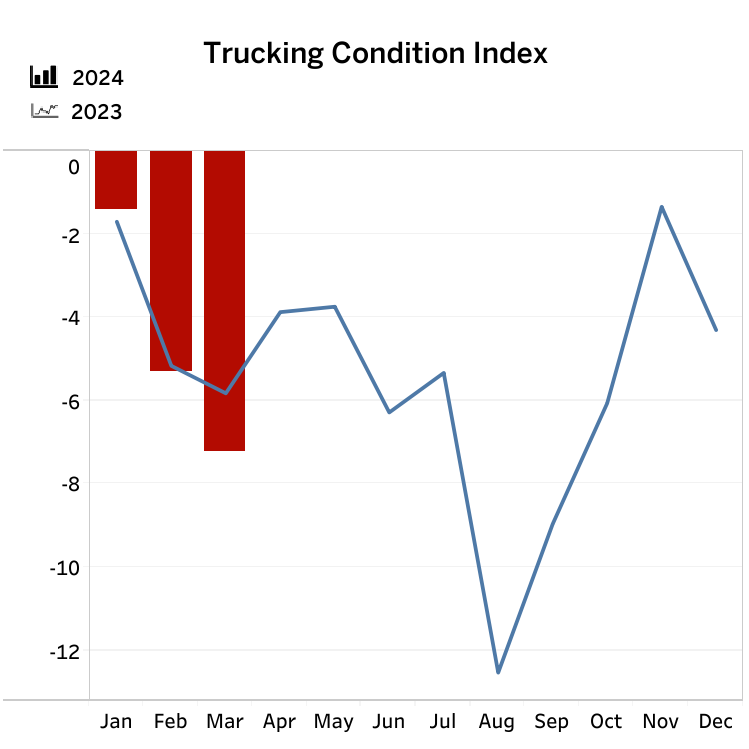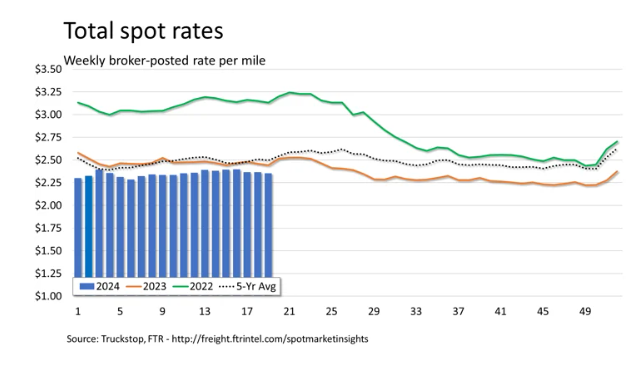ECONOMIC TRUCKING TRENDS: Freight recession to end in September, Motive predicts
Preliminary trailer order numbers for April show a sluggish market, and buyers are likely to prioritize buying tractors when cash allows. This, to get ahead of costly EPA27 emissions standards.
The spot market was flat in the most recent week, but a carrier survey shows improving sentiment. Motive, meanwhile, is making a bold prediction that the freight recession will come to an end in September. Lots to digest…
Trailer orders challenged
ACT Research reported preliminary net trailer orders of 13,700 units in April, up 21% year over year.
“Against year-ago data, with pent-up demand beginning to wane and supply chain congestion, for the most part, cleared, order activity continues to meet expectations,” said Jennifer McNealy, director commercial vehicle market research and publications.
“Despite the positive year over year comparison, net orders remain challenged by a backdrop of weak for-hire trucker profitability, albeit with some green shoots of improvement beginning to show. Anecdotal commentary from trailer manufacturers and suppliers through the past several months have indicated this slowing, as they have shared that orders are coming, but at a more tepid pace when compared to the last few years.”
ACT says improving fleet profitability in the back end of 2024 will likely not benefit the trailer industry, as fleets are more likely to prioritize buying power units ahead of costly EPA27 emissions requirements.
“Additional anecdotal information we’ve heard this month from those on the front lines of the trailer industry is that the ‘pause button’ is expected to remain pressed during this year of transition,” McNealy added.
“The industry’s largest segments remain under pressure, cancellations are anticipated to continue their oscillation into and out of elevated territory as dealers and fleets recalibrate their inventory and immediate needs, and external forces like the U.S. and Mexican presidential elections and interest rates remain on the closely watched list.”
ACT slashes trailer market forecast
With that in mind, the industry analyst slashed its forecast for trailer orders.
“The trailer forecast receives a more substantive haircut this month, driven primarily by Class 8 overcapacity persisting longer in 2024, weighing heavily on carrier profitability in a period where carriers are more likely to continue spending on Class 8 units due to an expensive EPA mandate landing in 2027,” said Kenny Vieth, ACT’s president and senior analyst.
“We revisited our trailer forecasts based on these near-term considerations: carrier profits, overstocked trailer dealer inventories that are proving hard to move, a short and soft peak order season, and increasingly diminished backlogs.”

Trucking conditions fell in March
FTR’s Trucking Conditions Index fell to -7.25 in March, its most negative reading since September 2023. The industry analyst blames weaker rates for the decline, while financing costs also were a factor.
“Rates had been a slightly less negative factor for carriers recently, so March might prove to be an outlier in what we expect will be a gradually improving environment for trucking companies,” said Avery Vise, FTR’s vice-president of trucking.
“However, we are not forecasting that either freight rates or overall market conditions will be favorable for carriers until early next year. Freight volume improvement and capacity rightsizing are progressing only incrementally, and we do not see anything on the horizon that clearly will change those dynamics. One factor we are watching is the cost of commercial auto insurance. Government data indicates steady increases in premiums over the past year after several years of mostly stable pricing. Continued increases might become a catalyst for accelerated carrier failures, which could yield a tighter market a bit earlier than we are forecasting.”

Spot market rates decline
Seasonal declines to spot market rates were seen in the week ended May 10, though decreases were consistent with the same week last year. But they should get a boost this week due to the International Roadcheck enforcement blitz.
Truckstop reports the Roadcheck blitz “almost always yields a sizable increase in spot rates due to trucking capacity being sidelined as many drivers avoid the hassle and scrutiny. During the same weeks in 2022 and 2023, total spot rates rose about 7 cents week over week with especially large gains in dry van and refrigerated.”
With load postings up in the most recent week, and truck postings down, the Market Demand Index improved to 74.9, its highest reading in four weeks.
Carrier sentiment improving
A new Bloombert-Truckstop survey of owner-operators and small fleets indicates sentiment is improving, but some concerns linger.
“The industry is emerging from a challenging quarter, and the improved sentiment coupled with Truckstop’s rising Market Demand Index suggest rates may move higher from here,” said Lee Klaskow, senior freight transportation and logistics analyst at Bloomberg Intelligence. “The direction of rates will be driven by supply-side factors as the industry remains flush with capacity.”
Sixty-two per cent of responding carriers said they saw lower freight volumes in Q1, but 33% expect improvements in the next three to six months. More respondents expect rates to rise (28%) than in the previous quarter’s survey. However, 44% were unsure about their status in the next six months while 9% said they’re ready to pack it in.
More than three quarters said rising interest rates in Q1 affected their businesses.
Motive becomes more bullish
Telematics company Motive put out its monthly economic report with a bold prediction.
“Motive is going beyond its previous prediction of a more carrier-friendly market in 2H and believes the most protracted freight recession in history will end by September of this year,” the company said.
It is expecting the market to see its first net positive growth since 2022 in September. Its Big Box Retail Index showed a third straight month of increased warehouse visits for the Top 50 U.S. retailers. Motive predicts demand among brick-and-mortar retailers will remain strong through Q3.
“While the freight recession is on its way out, its effects will not leave the market overnight. Yes, the overall lower trucking capacity it caused coupled with higher demand are positive signs for transportation and logistics businesses, but we do not expect a large correction for the overall market,” Motive said in its report.
“We anticipate price improvements will hit spot rates first, and the overall rebalancing of the market will be gradual. It’s worth noting that improvements will also be dependent on the U.S. economy continuing to grow.
In April, 1,149 U.S. trucking companies exited the market, a 69% decrease form January. There were 8,769 new entrants. This marks the first period of carrier growth in nearly two years.
Have your say
This is a moderated forum. Comments will no longer be published unless they are accompanied by a first and last name and a verifiable email address. (Today's Trucking will not publish or share the email address.) Profane language and content deemed to be libelous, racist, or threatening in nature will not be published under any circumstances.